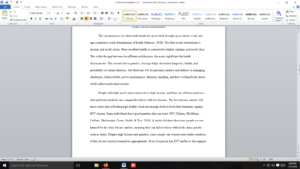Health disparity
There are significant differences in the quality and span of life between individuals and some populations experience a disproportionate amount of disease burden. This assignment will identify a health disparity and discuss social determinants of health, epidemiology, cultural considerations, and health care literacy.
Assignment Criteria:
For this assignment, develop a scholarly paper that includes the following criteria:
1. Identify and define health disparity related to the advanced practice nurse’s area of practice or chosen specialty.
a. Some examples include asthma, cancer, cardiovascular disease, stroke, diabetes, obesity, low birth weight, infant mortality, HIV/AIDS, TB, Depression, Schizophrenia, Substance Use Disorders, suicide, homicide.
2. Discuss three social determinants of health.
3. Describe how the three social determinants of health could influence the identified health disparity.
4. Identify the epidemiology associated with the chosen health disparity.
a. Specify the incidence at the state level
b. Specify the incidence at the national level
5. Describe the cultural considerations related to the chosen health disparity.
6. Describe the health care literacy challenges of the population impacted by chosen health disparity.
7. The scholarly paper should be in narrative format, 4 to 5 pages excluding the title and reference page.
8. Include an introductory paragraph, purpose statement, and a conclusion.
9. Include level 1 and 2 headings to organize the paper.
10. Write the paper in third person, not first person (meaning do not use ‘we’ or ‘I’) and in a scholarly manner. To clarify: I, we, you, me, our may not be used. In addition, describing yourself as the researcher or the author should not be used.
11. Include three professional peer-reviewed scholarly journal references to support the paper (review in Ulrich Periodical Directory) and be less than five (5) years old.
12. APA 7 format is required (attention to spelling/grammar, a title page, a reference page, and in-text citations).
Requirements: 4-5 pages excluding the title and references pages | .doc file
Answer preview
The number of Blacks/African Americans who made the new HIV diagnosis in 2019 comprised 13% of the U.S. population, which constituted 44% of a new diagnosis of HIV. In 2019, 18% of the U.S. inhabitants were Hispanics/Latinx, but 30% comprised new diagnoses of HIV. The numbers of Black/African American, Whites, Asians and multi-race people who had HIV diagnoses have declined during 2015–2019. Among American Indians/Alaska natives, HIV diagnoses grew and stayed steady with Hispanic/Latinos among Americans/other Pacific Islanders (Milbar & James, 2021). An estimated 1,2 million U.S. citizens 13 years and older had HIV by the end of 2019. Roughly 13% of individuals in the United States do not know this; thus, testing is necessary. Early diagnosis of HIV is essential. For all aged 13-64 years, there was a need to be tested at least once (Milbar & James, 2021).
[1444 Words]
Health disparity


